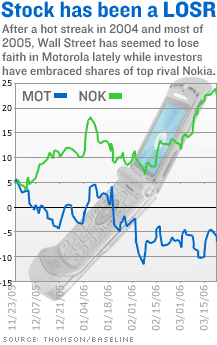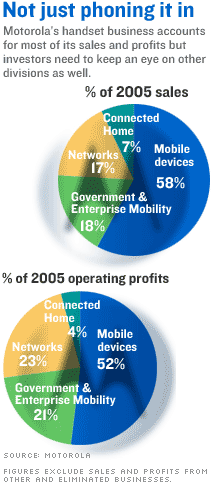|
Will Motorola be a WNNR in 2006?
After a banner '05, Motorola's stock has slipped. Is it still a good buy?
NEW YORK (CNNMoney.com) - For Motorola, 2005 clearly was the year of the RAZR. Thanks largely to that sleek, ultra-thin flip phone, by far the company's most iconic brand since its hugely popular '90s-era Star Tac model, Motorola's (up $0.25 to $22.28, Research) cell phone shipments jumped 40 percent last year. Overall, Motorola's sales increased by 18 percent last year and profits more than doubled.
And investors rewarded the company. Shares shot up more than 30 percent last year. But such a hot streak raises inevitable questions about whether Motorola can remain the cutting edge company in the cell phone market. Shares have slipped so far this year, while shares of top rival Nokia have gained 12 percent. Questions abound regarding Motorola's new product lines. Some wonder if the company's new SLVR phone, an ultra-slim non-flip phone, will be a hit, and some analysts say its new PEBL phone has been marginally disappointing. Then there's the ROKR, the company's clunky, iTunes-enabled phone that failed to catch on with consumers despite the cultural cachet that a partnership with Apple (Research) was supposed to provide. And after a technical glitch in some RAZR models caused cell phone carriers T-Mobile and Cingular to stop selling the phone for a few days this month, some wondered whether Motorola had returned to its post-Star Tac, pre-RAZR era of market share losses, missed opportunities and fumbled execution. Still, despite these stumbles, industry watchers say the RAZR-era Motorola is much better at launching desirable new products than it was before the company hired CEO Ed Zander in late 2003. "They seem to have gotten their act together," said Rich Crable, an analyst at Loomis Sayles, which owns shares of Motorola in three of its funds. But Crable also knows that the RAZR will be a tough act for Motorola to follow. "The biggest issue in my mind is, can they maintain that type of momentum?" he asked. Saying yes to Nokia
The company faces these questions at the same time that its number one rival, Finnish cell phone giant Nokia (up $0.07 to $20.38, Research), is making a comeback. Nokia, which boasts twice Motorola's global market share, had a strong 2005 after performing poorly in comparison to Motorola in 2004. As of the end of the fourth quarter of 2005, Nokia had a 35 percent share of the global cell phone market, compared to 17.8 percent for Motorola, according to data from technology research firm Gartner Group. Nokia launched more competitive products in 2005 and is currently eating Motorola's lunch in the world's two hottest growth markets for cell phones, India and China. Ittai Kidron, an analyst with CIBC World Markets, estimates that Nokia claims a whopping 65 percent market share in India, compared to Motorola's measly 10 percent. But Kidron said that while he thinks Nokia is well-positioned to increase its market share even further in India, he thinks Motorola is similarly well-positioned. Kidron and other analysts agree that both companies will likely gain share in these countries at the expense of smaller, local players. Because Motorola got to the market late, the company had to figure out the unique problems associated with distributing phones in those regions -- problems Nokia had already sorted out by the time Motorola got there. "Motorola was late, but they have fixed the problems," said Crable of Motorola's approach to the India and China markets. "Those geographies should be a significant driver for the company." Outside the cell
Cell phones account for nearly 60 percent of Motorola's sales, but they're not the full picture. Analysts say the company's other units are a mixed bag when it comes to growth potential. The company has a steady, profitable business in its government segment, which sells secure communications equipment to federal and state governments, such as two-way radios for police and security personnel. That business is expected to grow slightly this year, thanks to increased demand for its products from homeland security personnel. But Motorola's networks business, which builds infrastructure for wireless networks and was recently folded into the government unit, faces some uncertainty. The division's biggest customer, Nextel, was acquired by Sprint (Research), which means a possible loss of business for Motorola, analysts say. Nextel's network was built on proprietary technology from Motorola, but the Sprint acquisition raises doubts about whether Sprint will still use Motorola technology once the two companies merge their networks into one. Analysts say the company's brightest growth prospects outside of cell phones lie with its smallest division, the "connected home" segment. This unit makes cable set-top boxes and also provides fiber to telephone companies who are hoping to deliver digital video to customers. According to CIBC's Kidron, Motorola should benefit as telephone companies ramp up their spending in this segment in order to compete more effectively against cable companies. Moto still has its mojo
Still, cell phones are the company's cash cow, and the biggest question hanging over Motorola is whether it can continue the momentum that RAZR built. Crable of Loomis Sayles pointed out that cell phone consumers are highly fickle, making it difficult for cell phone makers to produce back-to-back hit products. Also, Motorola's competitors are all gunning to make uber-thin phones that mimic the RAZR, he said. Analysts and investors say that while 2006 probably won't produce the blowout gains of 2005, the company's RAZR brand is still strong. "The company is not going to go from 100 miles per hour with RAZR to a dead stop," said Crable. Kidron said that globally, he expects Motorola to gain market share, breaking through the 20 percent mark by the end of 2006. That growth will come in part from a re-designed RAZR, he said. As such, analysts still expect healthy growth for Motorola this year, with projections of an 11 percent increase in sales and a 15 percent jump in profits. Said John Slack, equity analyst at Morningstar, "You are not going to see a year like you saw last year, but in this kind of market, if you can get 10 to 15 percent over the next year, that's not a bad return." And with the stock trading at only around 16 times expected 2006 earnings, analysts say that it's a good value, even if earnings and revenue growth face inevitable declines from last year's torrid pace. Nokia, by way of comparison, trades at about 20 times 2006 earnings estimates, even though its growth outlook is slightly lower than Motorola's. Analysts quoted in this story do not own shares of Motorola and their firms do not have banking ties to either company. -------------------- Here come the unhip tech stocks: Click here.
Apple rings up an iPhone: More here. |
|




